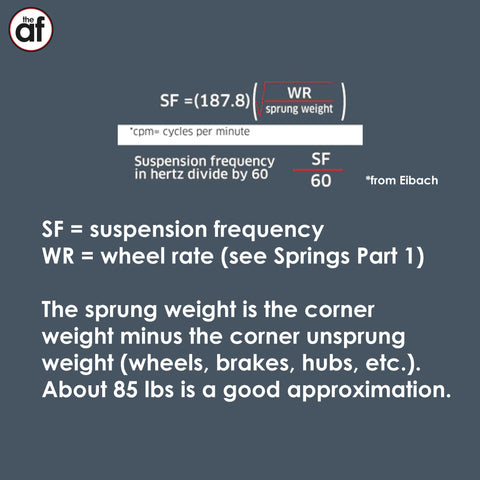Your Cart is Empty
Get on track. 2022+ BRZ/GR86 and 2022+ WRX products in stock now!
Get on track. 2022+ BRZ/GR86 and 2022+ WRX products in stock now!
Get on track. 2022+ BRZ/GR86 and 2022+ WRX products in stock now!

August 05, 2020 2 min read
In part 1 of our series on springs, we learned how to use motion ratios to calculate the stiffness of our springs at the wheels. Figuring out the wheel rates of your existing suspension is helpful, but actually choosing spring rates for a new suspension can be complicated.
To properly design a suspension for a car’s weight, aerodynamics, and tires, we often use suspension natural frequencies as a starting point for picking wheel rates and spring rates.
Common suspension frequencies:
Suspension frequencies are the rate (in cycles per unit of time) that a spring oscillates after applying a load (or hitting a bump). A suspension with stiff springs and a high frequency will oscillate more quickly than the same car with soft springs. This does not include the effects of dampers.
Suspension frequencies take into account both the wheel rate and the supported corner weight, allowing us to make comparisons of the relative suspension stiffness of cars with different weights.

The sprung weight is the corner weight minus the corner unsprung weight (wheels, brakes, hubs, etc.).
One common idea is to design for “flat ride,” which is to have the rear suspension frequency roughly 15% stiffer (or faster) than the front. The idea is that since the front hits a bump before the rear, the rear should be a little stiffer in order to settle at the same time.
Flat ride was initially designed to improve comfort on vehicles with soft dampers, but it’s also useful for sports cars. Many racecars do not use flat ride and there can be benefits to higher front frequencies.
Identical suspension frequency front and rear (no damping)
“Flat ride” with faster/stiffer rear frequency (no damping)
Ultimately, the best spring rates for a race car are the ones that allow it to go fastest around a track. This rarely comes from plugging numbers into a formula, but suspension frequencies and flat ride are useful starting points.
Many variables are not accounted for with these methods, including sway bars and alignment settings. What works for a rear wheel drive car may not work for a front wheel drive car.
Another useful data point is Total Lateral Load Transfer Distribution, which we’ll discuss in another post.